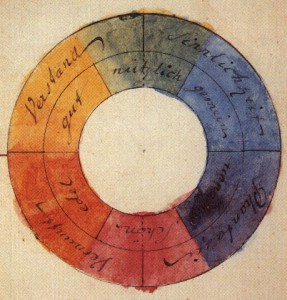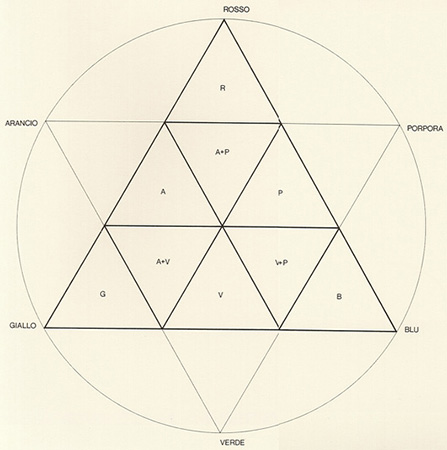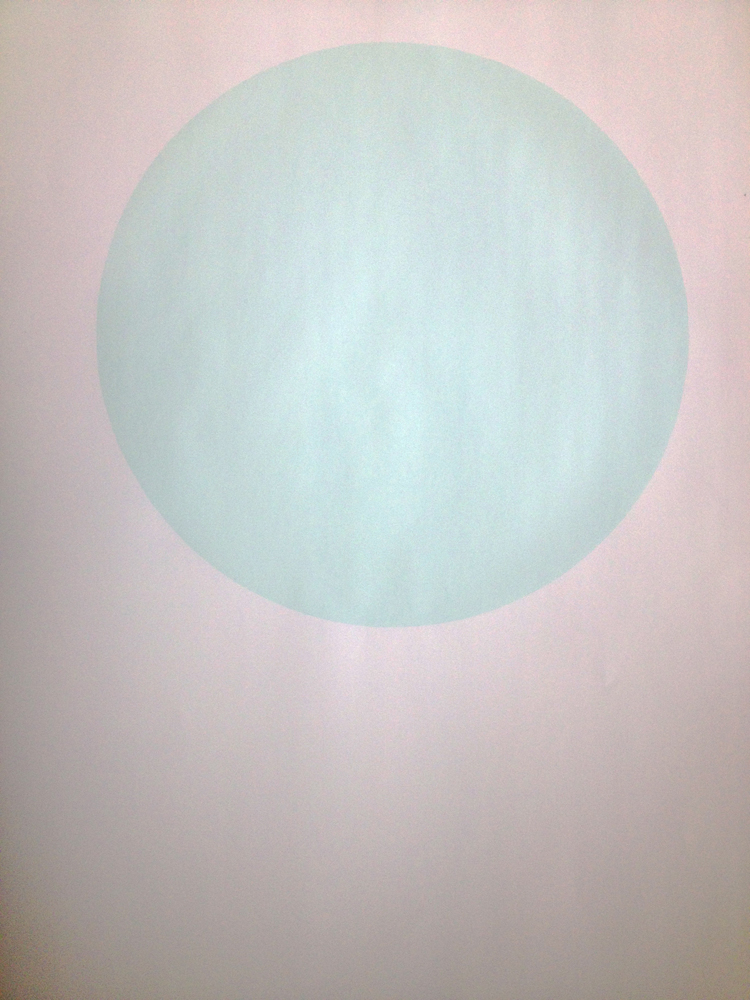Johann Wolfgang Goethe (28 August 1749 – 22 March 1832) was a German Writer, artist and politician. Goethe devoted a large part of his life to the study of natural phenomena. Although Goethe especially was known as a poet, he saw his own scientific work as his greatest merit. Yet few had appreciation for Goethe’s scientific work, though some modern scientists, like Henri Bortoft and Reinhold Sölch, get greater understanding of Goethe’s learning.
Johann Wolfgang Goethe analyzed colours from a physical perspective. In his views, there are two basic colours: cyan and yellow. Cyan originates from viewing dark through light, like you view the sky during the day. Yellow originates from viewing light through dark, like you view light in a dark area. Goethe based his colour theory on this interaction between light and dark.
The intensification of the basic colours leads to other colours. If the colour yellow is intensified, it leads to red. If blue is intensified, it leads to violet. This can be seen in the sky when the sun goes down. This is also an explanation for the categorization of cold and warm colours. According to Goethe green is the neutral colour between cold and warm, like the colour of plants. Magenta, or purple as Goethe calls it, is the balanced connection between light and dark, because it carries light as well as dark elements.
The colour theory of Goethe can thus be seen as the star of David. Two similar shaped triangles lapping over each other: a triangle that faces down and an overlapping triangle that faces up. The triangle that faces up has cyan in the lower left corner, yellow in the lower right corner and magenta in the upper corner. The triangle that faces down has violet in the upper left corner, red in the upper right corner and green in the lower corner. Smaller triangles can be extracted from the two large triangles that show alternative possibilities. In these smaller triangle Goethe pays attention to secondary and tertiary colours. He also analyses colors in relation to psychology. Colours ranging from yellow to red are analyzed as the plus-side, whereas colors ranging to blue are referred to as the minus-side. Here Goethe connotes the plus-side with warm, positive associations and the minus-side with more dark, negative associations. This is what he calls the sensual-moral effect of colours.
The German poet and philosopher Johann Wolfgang von Goethe describes a journey through the Harz Mountains in a very compelling manner, in the middle of the winter. The reader will be absorbed by his writing, like he would be walking around in a painting, when he writes about vague violet shadows of a group of trees and overhanging rocks in the noonday sun lighted by a yellow snow. As the hours pass, these shadows deepen from a deeper blue to a dark yellow-orange tone sunlight. As the sun reaches the horizon and a purple light covers the entire landscape in a red glow, the shadows turn green. Goethe describes almost a fairy-tale like landscape painted in the colors red and green. The story is part of Goethe’s color theory and is a typical example of the empirical experiences on which this theory is based.
Goethe’s color theory was published in three sections: If Beiträge zur Optik I (1791) and II (1792) (part III, Von den Farbigen Treasures remained unpublished), if Didaktischer Teil in 1808 and finally in its entirety, under the title Zur Farbenlehre in 1810. It is an extensive work with a special status in the world of culture and science. From the beginning there were numerous outspoken advocates and critics. Present day Goethe’s color theory is not considered scientific, i.e. not in accordance to the scientific physical principles based on Newton. In the Romanticism around 1800 science was viewed in a much broader sense. Natural philosophers intermingled empirical research with their own vision and passion, based on literature and art. In their views colors were not only physical wavelengths, but also individual observations with the sentimental values and emotions.
Artists, especially landscape painters, felt a deep connection with this way of reflecting on colours. They viewed colours and reproduced them in a manner that the viewer could relive this observation. Pure scientific facts are not enough to describe the color world, in their views.
Twilight sinks down from above us,
Swiftly all the near is far:
But first shining high above us
Radiant is the evening star!
Everything is drifting vaguely,
Mist steals upwards to the height:
And the still lake mirrors darkly
Black abysses of the night.
Now in all the eastern distance
I suspect moon’s gleam and glow,
Slender willow’s trailing branches
Dally with the neighboring flow.
Through the play of moving shadows
Trembling lunar magic shines,
And a soothing coolness follows,
To the heart now, through the eyes.
When I started reading his poems, I immediately linked the poems to his colour theory. The romantic way of describing the natural phenomena inspired me to collect all sentences that actually describe a specific light of the day in different landscapes. His words spoke to my imagination and it naturally formed the idea to search for the landscapes, which refers Goethe to. I found a big collection of images and made a selection out of it. Because Goethe’s Theory was based on the light we see in nature I have chosen a film projection. In this setting the viewer can immediately disappear in the meaningful words centered in a similar surrounding as a sort of meditation.
The moment I had to make silkscreen-printed colour, I was compelled by the appearance of the moon after reading this poem and tried to bring this feeling back in just one colour.







